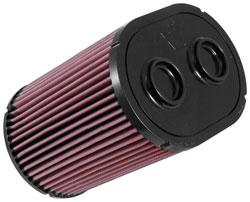|
Moreover, airflow can have certain characteristics that could cause it to deposit the particles in a filter that can assist in affecting the air pressure differential within and without the air filter. If this occurs, then airflow is restricted limiting the filter’s performance. The physics of airflow has identified three principles that determine how an air filter removes dirt particles from the air stream. Each principle can affect the air pressure within the filter. These principles include interception, impaction, and diffusion. The first principle is known as interception. This references the dirt particles that travel through the filter with the air stream. Studies show that airflow will always take the shortest path. As the airflow carries the particles through the filter fibers, they contact the sides of the fibers and are captured and then held in place due to the tacky oil that is covering the cotton strands.
The principle of diffusion deals with the laws of physics that manage the motion of very small dirt particles. Forces in the air stream greatly influence the way small particles travel. These forces include velocity and pressure changes, and turbulence that occurs due to particles interacting with air molecules causing very small particles to travel randomly and chaotically. As a result, the particles do not follow the air stream and their erratic movement causes them to collide with the filter’s fibers. This allows the air filter to capture dirt particles that are much smaller than the openings in the media. Moreover, the multi-layered cotton gauze media offers many levels that are allowed to capture and retain particles. This permits the K&N filter to hold considerably more particles per square inch of media than an average paper filter. To better understand, let’s take a look at how a paper filter works. A paper air filter must be thick and/or the fibers must be tightly compressed and dense to meet minimum filtration standards. As a result, the paper filter is more restrictive to airflow by design. As a paper filter becomes more and more clogged, the pressure within it drops while the atmospheric air pressure outside the filter remains the same. As the pressure differential becomes too great, the filter will become more and more restrictive causing the airflow to pull dirt particles through the paper medium. The ability of the paper air filter to perform due to its restrictive condition adversely affects its ability to protect the engine. As dirt builds, passages are blocked and the paper filter must be replaced after only 10,000 miles of use. The Frazier Permeability Test confirms that the multi-layered cotton gauze medium of the K&N air filters flow more than 300% more air than a paper air filter medium when compared on a square inch per square inch basis. Another added benefit of the K&N replacement air filter with a multi-layered cotton gauze medium is that it is washable and reusable and designed and engineered to last up to 50,000 miles before cleaning is required (depending on driving conditions). K&N is so sure of the quality of the air filter it backs it with a K&N 10-Year/Million Mile Limited Warranty that promises that the filter will perform for up to 10 years or 1,000,000 miles without need of replacement. The K&N E-0644 is designed to fit the following vehicles: 2017 FORD F550 SUPER DUTY 6.7L V8 Diesel Engine - All Models 2017 FORD F450 SUPER DUTY 6.7L V8 Diesel Engine - All Models 2017 FORD F450 SUPER DUTY 6.2L V8 Fuel Injection - All Models 2017 FORD F350 SUPER DUTY 6.7L V8 Diesel Engine - All Models 2017 FORD F350 SUPER DUTY 6.2L V8 Fuel Injection - All Models 2017 FORD F250 SUPER DUTY 6.7L V8 Diesel Engine - All Models 2017 FORD F250 SUPER DUTY 6.2L V8 Fuel Injection - All Models |
|||
Wednesday, September 13, 2017
K&N Air Filter Designed to Boost Horsepower on 2017 Ford Super Duty Trucks
Subscribe to:
Post Comments (Atom)


No comments:
Post a Comment